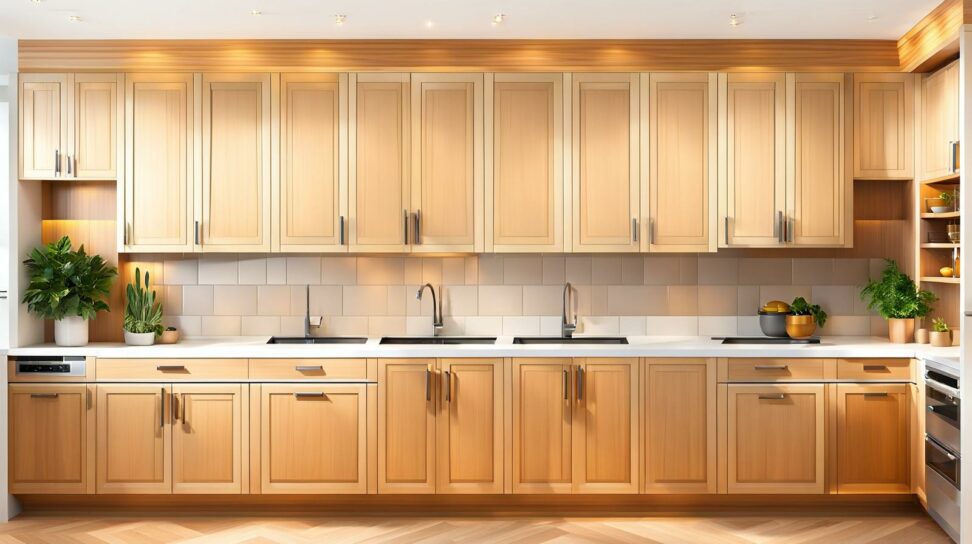What is the Standard Kitchen Cabinet Size? Your Complete Guide
When remodeling or building a new kitchen, getting the cabinet sizing right is crucial. The standard kitchen cabinet dimensions you choose impact aesthetics, functionality, and workflow. Cabinet sizes that don't fit your space well can lead to problems down the road.
With these kitchen cabinet size standards, you'll be able to design an efficient, organized, and gorgeous kitchen tailored to your needs.

Typical Base Cabinet Dimensions
Base cabinets are the foundation of your kitchen design. Here are the common base cabinet sizes and considerations:
Standard Base Cabinet Heights
The typical height for base kitchen cabinets is 36 inches. This allows for convenient access without excessive bending or reaching. For a more modern look, some designers opt for taller 42 inch base cabinets. For accessibility, ADA compliant cabinet height is 34 inches.
When determining your base cabinet height, make sure to account for the counter top thickness. Leaving adequate clearance between the counter top and wall cabinets is key for functionality.
Common Base Cabinet Depths
The standard depth for base cabinets is 24 or 25 inches. This depth provides ample storage space for large pots, pans, and appliances.
More shallow cabinet depths like 18 or 21 inches are also available. Just keep in mind that shallower cabinets limit storage capacity.
Standard Base Cabinet Widths
Base cabinet widths typically come in increments of 3 inches, starting from 9 inches all the way up to 48 inches for larger pieces like ranges or refrigerators. The most commonly used widths are:
- 18 inches
- 21 inches
- 24 inches
- 27 inches
- 30 inches
- 33 inches
- 36 inches - This is the most popular since it fits standard countertop sizes.
For corner cabinets, larger widths are sometimes required to maximize use of the space.
Toekick Height
Toekicks, the recessed space under the cabinet doors, are crucial for providing proper clearance. Typical toekick height ranges from 3 1/2 to 5 inches high.
Take toe kick measurements into account when planning your base cabinet heights to ensure your doors and drawers won't get obstructed.
Typical Wall Cabinet Sizes
Wall cabinets provide essential storage space while keeping your countertops free. Here are the standard upper cabinet dimensions:
Common Wall Cabinet Heights
Standard upper wall cabinet heights range from 30 to 36 inches. The most common wall cabinet height is 36 inches. The exact height depends on the distance between your counter top and ceiling.
Make sure to measure the ceiling height accurately to determine the optimal wall cabinet size. Leaving at least 18 inches of clearance between the counter top and wall cabinets is recommended.
Standard Wall Cabinet Depths
The typical depth for wall cabinets falls between 12 and 13 inches. This depth provides adequate storage while preventing cabinets from feeling too deep or inaccessible.
Some designers do opt for deeper 15 to 18 inch cabinets, but just keep in mind that deeper wall cabinets can be difficult to reach into.
Typical Wall Cabinet Widths
Wall cabinet widths span anywhere from 12 inches for filler cabinets to a maximum of 48 inches for large panorama cabinets. The most common widths are:
- 18 inches
- 24 inches
- 30 inches
- 36 inches
Using widths in 3 inch increments creates a uniform and seamless kitchen cabinet design.
Specialty Cabinet Dimensions
In addition to standard base and wall cabinets, also factor in dimensions for any specialty cabinetry:
- Corner cabinet width and accessibility
- Ample room around an island for seating and circulation
- Accommodating oven cabinet height and width
Planning Your Kitchen Cabinet Layout
Now that you know the basic kitchen cabinet sizes, it's time to start planning your layout. Here are some tips:
- Precisely measure your existing kitchen or new space.
- Map out different configurations like L-shaped, U-shaped, or G-shaped designs.
- Use the standard cabinet dimensions as a guide to select cabinet sizes.
- Work with a professional designer for customized sizing if needed.
With some careful planning using these standard kitchen cabinet size guidelines, you'll be well on your way to creating your dream kitchen.
When it comes to kitchen cabinet dimensions, measuring correctly is crucial. Even small measurement errors can lead to issues with cabinet installation and functionality down the road.
Use this guide on standard kitchen cabinet sizes to understand the typical heights, widths, and depths to properly size your space. With the right cabinet measurements, you can maximize storage, aesthetics, and create an efficient kitchen layout.